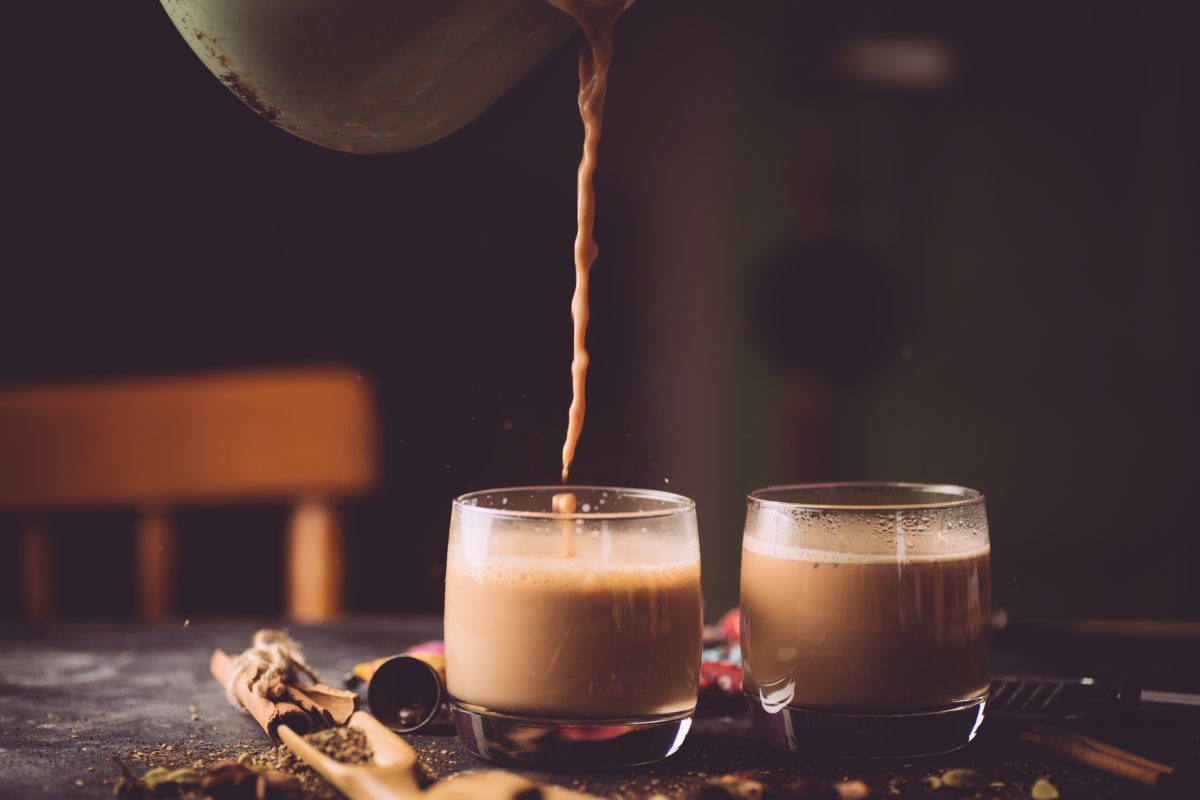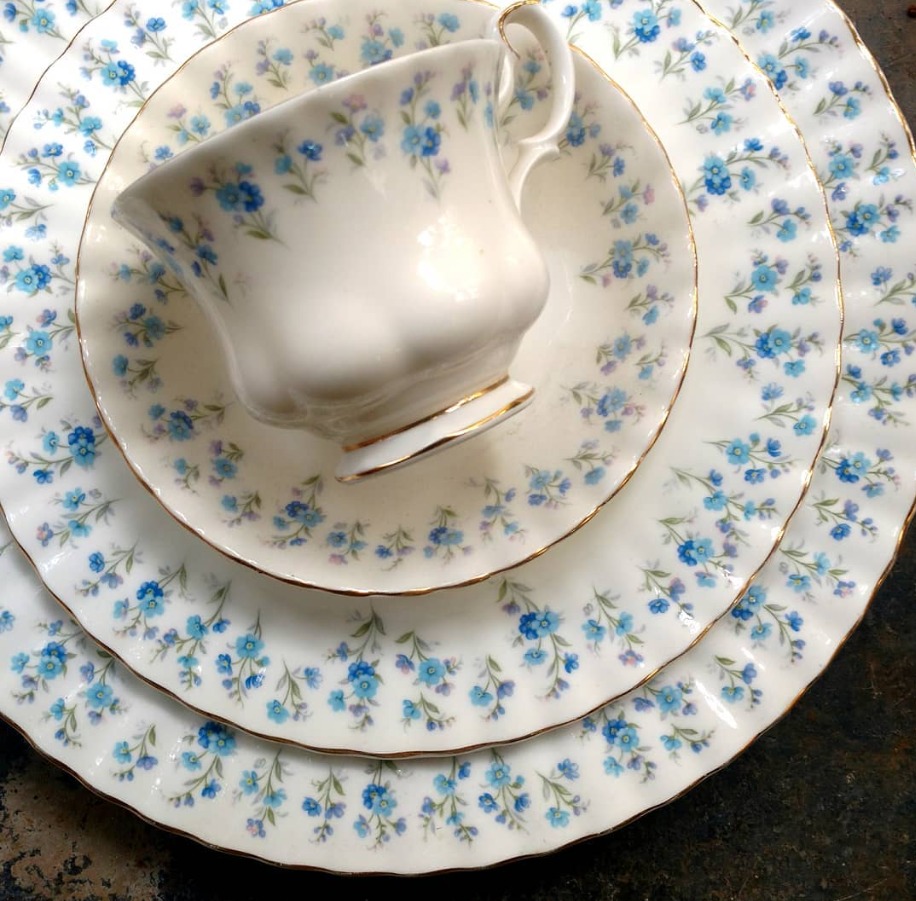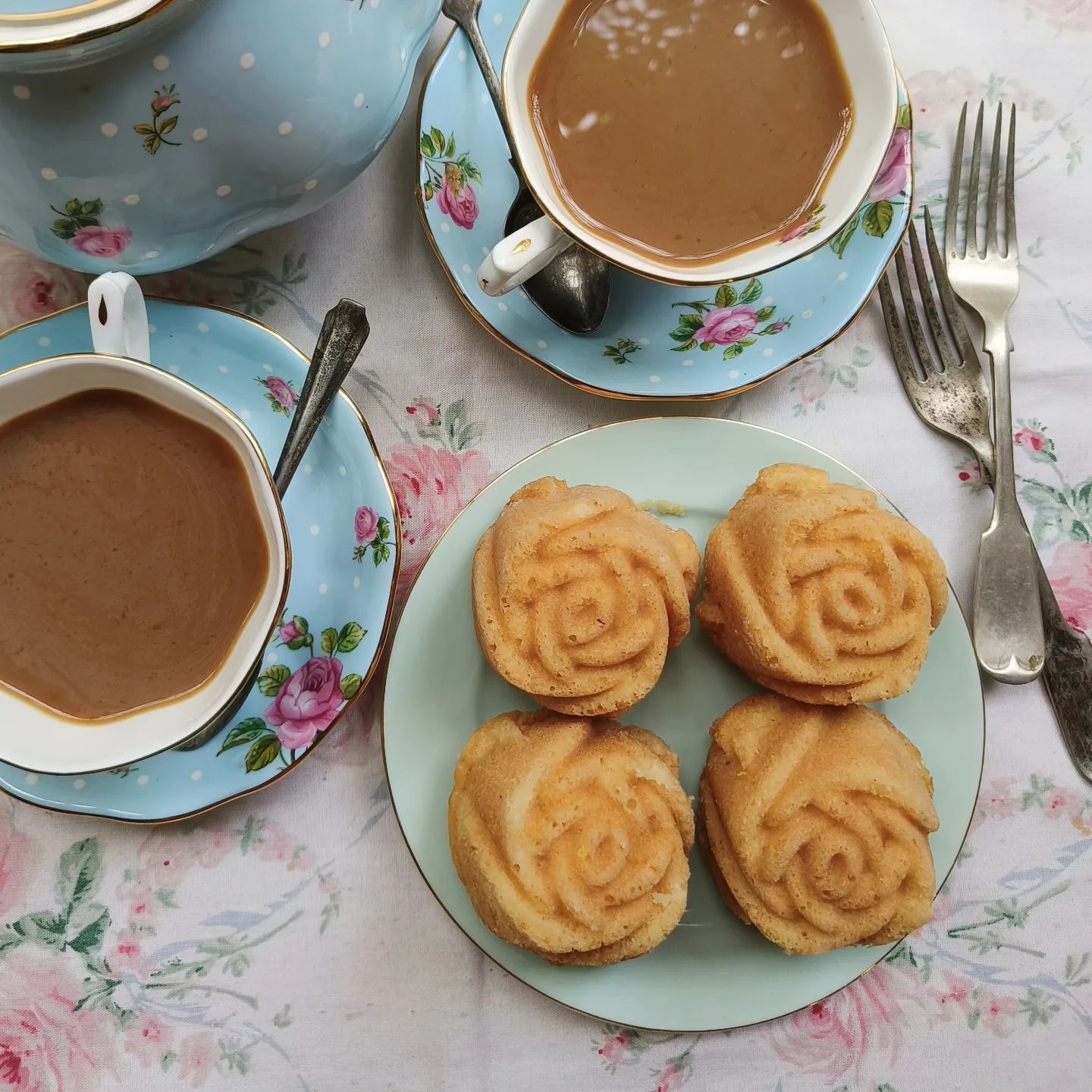In Didin’s (my maternal grandmother’s) house in Kolkata, many storage cupboards with glass doors were set into the thick walls. And in one of these was the ‘Japani tea set’. It was the most luxurious of all the tea paraphernalia that the family-owned and, as my mother told me once, was often borrowed by the extended family living nearby whenever they had important guests for tea. Tea was undoubtedly a very important part of daily life in Didin’s house and though the elaborately decorated Japani tea set was not used very often the daily tea ware was always good bone china from Hitkari or Bengal Potteries.
I was the only granddaughter in the house and it’s fair to say I was quite pampered when we visited Kolkata every summer. One of the treats was being served tea in a cup from that Japani set with a slice of cream cake or some savoury goodie on a plate from the same set. Everyone held their collective breath while I enjoyed my tea and relaxed only when the pieces were washed, dried and put back into the dewal almari or wall cupboard! This was not restricted to Didin, I pestered all her sisters who lived nearby into serving me tea in their beautiful china. A day would be fixed and I would be allowed to choose the set which I would be served in. Some of my happiest Kolkata memories are these tea memories of beautifully set table with all the pretty china, Darjeeling tea lightly brewed, and a smorgasbord of sweets and savouries just waiting to be dug into! The cakes and savouries would come from Flury’s or from Kathleen and I knew there would always be a lemon tart among the chicken puffs, chicken sandwiches, and slices of chocolate cake.

My mashi (mom’s sister) and Moni (my mother) loved drinking tea and whenever they were together, they spent happy times brewing and enjoying their tea. It was always Lopchu Flowery Orange Pekoe, gently steeped in a proper tea pot covered with a tea cosy, and ultimately enjoyed in fine bone china tea cups. A splash of milk, which later became a mere touch of Nestle Milkmaid condensed milk, and a scant teaspoon of sugar would be added and then the cup would be enjoyed in silence. It was only once the second cup was poured that they would start a conversation and spend happy sister-time together. It goes without saying that whenever anyone visited us in Mumbai (Bombay in those days) they carried a packet or two of Lopchu Flowery Orange Pekoe for my parents. It’s not as if Lopchu tea wasn’t available in Bombay–PeeKay Wines at Crawford market, so well known as one of the biggest sellers of alcohol in the city, was a distributor for the Lopchu tea gardens and you can still see the signboard for the same outside their premises though the dealership is no more. However, we lived in the suburbs and going all the way to Crawford market was not always possible and the parents made do with long leaf tea from Lipton till the next stash of Lopchu arrived.
The two sisters often went shopping to second hand shops, antique stores, and even weekly markets looking for tea-ware. It’s thanks to them that I developed a love for pretty china and have inherited whatever is left from those shopping forays into places with names like Ghora’r Bajaar where they bought a lot of fine china–Noritake, Johnson Brothers, Aysnley, Royal Albert, and more. I would love to know where this Ghora’r bajaar used to be. So far, my inquiries have failed. Apart from the second-hand treasures, the two also kept an eye on the new designs emerging from Hitkari and BengalPotteries, frequently splurging on sets of cups and saucers and tea mugs to make tea time more pleasurable. Later, once he was all grown up and gainfully employed, my brother bought fine English bone china for them from his travels including a very pretty Royal Doulton set of a tea pot and two cups and saucers for the two sisters to enjoy together.

Journalist and food writer (and probashis like Mumbai resident) Rituparna Roy’s father is particular about his tea and gives her precise instructions on how it should be made. “When I’d return home on vacations, my parents especially my father would ask me to make cha. He still asks me to prepare it when I visit them. And he still instructs me to steep the leaves for exactly 4 mins. He continues to buy Darjeeling tea religiously from this specific store for more than 45 years now. It is funny how my parents carry tea leaves when they visit me in Bombay.”
However, not everyone in Bengal is so particular about the tea cups or is restricted to tea from a specific tea garden or shop. Tea is the elixir of the masses and there’s a cha-er dokan at every 200 metres on the streets of Kolkata and in towns and highways across the state serving boiled and sometimes spiced, strong milky tea. Every bus stand and train station is dotted with tea stalls and along with tea you can buy biskoot, toast, and myriad savouries to enjoy along with the tea. There was one right outside Didin’s house on Chowringhee and as I child I was fascinated by the big glass jars filled with all sorts of biscuits, toasts, etc., that customers enjoyed with their tea served in the ubiquitous earthen cups called bhnaar, integral to the street-side tea drinking experience. The stall also sold cigarettes by the individual stick and I would occasionally catch one of my younger uncles enjoying a quick smoke with their tea, away from prying family eyes!
Bhnaar’er cha, for most Bengalis, is an integral part of Bengali-ness, and though my parents didn’t stop at the roadside tea stalls in Kolkata, they did give in to its pleasures on the train journeys to Kolkata every summer. As soon as the train approached Bengal the cha walas would hop on with their huge aluminium kettles and buckets of neatly stacked earthen bhnaars and start calling out “Bhnaar’er cha! Bhnaar’er cha!” enticing the homesick probashi bangalis (Bengali diaspora) on the train into indulging in a sip of ‘home’.
Of course, tea drinkers can be a fussy and suspicious lot. Family legend has it that one of my maternal uncles couldn’t live without his daily cups of tea and whenever he travelled, he carried his own tea strainer. He firmly believed that the tea makers in the small stalls in the hills used old used socks to strain the tea and would insist they used his strainer whenever they made tea for him!
Tea is not always the same in many homes through the day. For Sayantani Mohapatra, entrepreneur and blogger, “Tea and coffee are staple at home. Morning and evenings are for milk tea.I try to add little fresh turmeric, pepper and ginger to our morning cuppa. Evening is for a light (very little milk)tea. Mid-morning, we prefer black tea (Earl Grey classic or black tea with some orange peels, Bengali style masala lebu tea, etc.” Sibendu Das, mishti afficionado and food researcher from Chandannagar, says “I love my dudh cha (milk tea) as much as my laal cha (red tea). Typically, in the morning, the first tea I sip is the laal cha, without milk or sugar. I personally prefer Darjeeling tea (Second Flush), from either the Gopaldhara Tea Estate or the Mission Hill Tea Estate. I need a strong dudh cha in the afternoon/evening. I prefer using Tata Tea Gold. And my dudh cha must have sugar in it. Often, I add a little bruised ginger to my milk tea.”
Tea is serious business indeed and as the day progresses tea serves different purposes, whether it’s the wake-up drink in the morning, the energizer in the middle of the day to keep one going, or the soothing cup at the end of a long day–for the Bangali cha is always the answer. Tea or cha is so deeply enmeshed in the Bengali’s life drinking tea often turns into a ritual without us even realizing it. Sibendu tells me “Usually, at home, my parents and I sit together for the breakfast tea. And we usually have it sitting on the bed.” Evening tea for my father was a quiet solo affair when he came home after work. He would sit in his cane easy chair in the living room and enjoy his tea in silence and solitude. My brother and I knew to leave him alone till he’d finished his tea. In the mornings my parents enjoyed their tea together at the dining table, my mother preparing and planning for her day ahead and my father reading the newspaper, and the two of them chatting and generally spending those few moments peacefully together. Drinking cha or tea is never just about what’s in the cup. It’s about spending time together with the ones you love, those that are close to you, the people who are important. It may just be a quick 10 minutes spent together on a road side with colleagues or a leisurely half hour at a beautifully set table, the tea is the excuse to be together for a while before life takes over.
If there is cha can ta be far away?! Every afternoon after his post lunch nap my Jethu (elder paternal uncle) would be found tinkering in the kitchen prepping for something to go with the evening tea. He would all sorts of fun snacks, sometimes a ghughni, sometimes a street style roll, or there would be aloo kabli, or chicken pakoras… the list is endless! Jethima, his wife, would often scold at the extra work he made for the women in the family but she gamely helped nevertheless. If nothing was made at home something would be bought from the nearby mishti shop – kochuri, singara, cutlet, or even begunis to perk up a plain bowl of muri mixed with chopped onions and mustard oil.

For Sayantani “It changed over time. When I started drinking tea (after I passed school final) it was always biscuits, marie to be precise. Then I learned baking and always had something homemade like tea cakes or cookies or savoury pastries. Now with age I have learnt to enjoy it on its own. Just tea without sugar. Occasionally we enjoy it with tele bhaja, especially alur chop.”
“In the evenings,” shares Sibendu “the ‘ta’ becomes more elaborate such as telebhaja (Bengali deep-fried delicacies such as aloor chop, fish chop, deem-er devil, etc), or fish fry, or ghugni-jhuri bhaja. Muri is an all-time accompaniment.”
For Rituparna tea is a simpler affair “If it’s morning tea, then usually a nonta biscuit to go with it. Cha and mishti biscuit don’t go together in our home. Same in the evening, maybe occasionally with shingara and muri. It’s rare these days though.”
My own mother, also a probashi, liked to have a couple of Thin Arrowroot biscuits with her tea. Sometimes my parents would have Cream Cracker biscuits instead. At some point Thin Arrowroot went off the market and mother had to move to the variety of ‘marie’ biscuits that were made by many companies but she never quite enjoyed them the way she enjoyed the Thin Arrowroot biscuits. However she liked to bake cakes and ever so often there would be a slice of simple vanilla pound cake to be had along with the tea.
For all the obsession with tea in Bengali households, most Bengali children weren’t given any. It was a drink for grown-ups and most of us tasted proper tea (not mixed into a full glass of milk!) when we were well into our teens and not so much under the control of parents and other family grownups. As Rituparna confirms, “As a child, drinking tea was a grown-up affair. I don’t remember my mother ever offering me tea, maybe she did when I turned 18. But my brother and I never developed a habit. Later when I’d return home on vacations, my parents especially my father would ask me to make cha.”
And it was the same for Sibendu “As a kid, I was never given tea, and was always told that it’s an adult’s drink. So, getting my first cup of tea was like getting the first taste of adulthood (for me alcohol came much later).”
Tea was off limits for my brother and me too and on those occasions when I was treated to a grand tea in the fancy crockery, I got very light tea which I wasted most of the time–I was more interested in all the snacks and sweets! I’m not fond of tea even today but my brother enjoys his ‘dip-dip’ tea made using the super convenient tea bags. From the delicately fragrant teas of Darjeeling to the robust Assam brews and so many varieties in between, cha is entwined in the Bengali soul be it sipped on the road side from a bh’naar, savoured in paper thin china, in a fancy rich man’s club, or slurped sitting on the bed on a nippy winter morning. The Bengali’s love for tea probably even outstrips their love for fish, we just don’t really realize it–our engines run on cha!